Estimated reading time: 5 minutes
There are many different approaches to mulching under fruit trees. Some people swear by it, and others rarely or never use it or recommend it.
We tend to be in the latter camp. But we’re always learning, and we definitely see the advantage of mulching in certain situations.
Our fruit-growing study tour of the USA got us thinking slightly differently about mulch. We saw a number of different approaches to it in our travels.
What’s the purpose of mulch under fruit trees?
Mulch is intended to suppress plants growing under your fruit trees. These plants are often called “weeds”, and they don’t have a good reputation.
Sadly but unsurprisingly, it’s not hard to find orchards where the weeds have been completely killed with herbicide. In that case, mulch isn’t needed because there are no plants left to suppress.
In fact, in most orchards around the world, killing all the plants under fruit trees is still considered to be best practise.
Yuk! Please don’t do that to your fruit trees. It’s an approach we moved away from in our orchard many years ago.
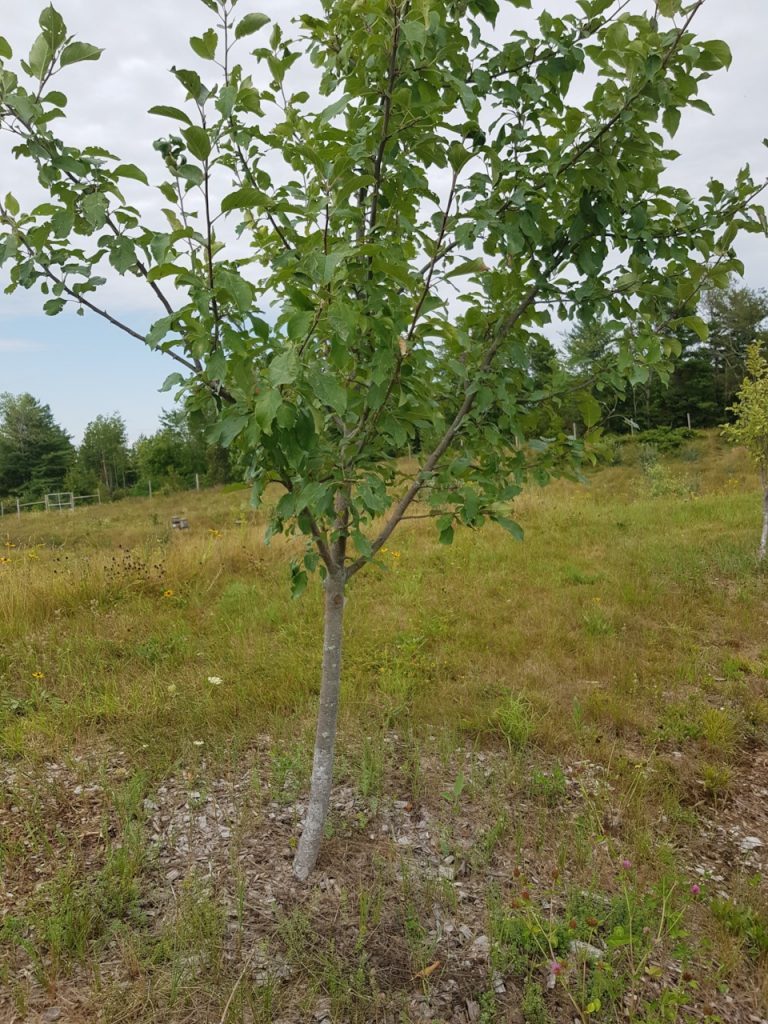
The risks of using weed sprays
There are so many good reasons not to use weed sprays (also known as herbicides). The chemicals are bad for your health. The weeds grow back and need spraying again, which is money straight from your pocket to the chemical companies. But worst of all – it’s really bad for the soil.
Weed sprays help to kill the natural fertility system (NFS) that trees rely on to get their nutrients. If you kill the NFS, you must rely on artificial fertilisers to feed your trees. That’s more money from your pocket to the fertiliser company.
There has also been speculation that using mulch may help prevent fruit fly. However, the evidence hasn’t supported it, so we recommend sticking to proven fruit fly prevention techniques.
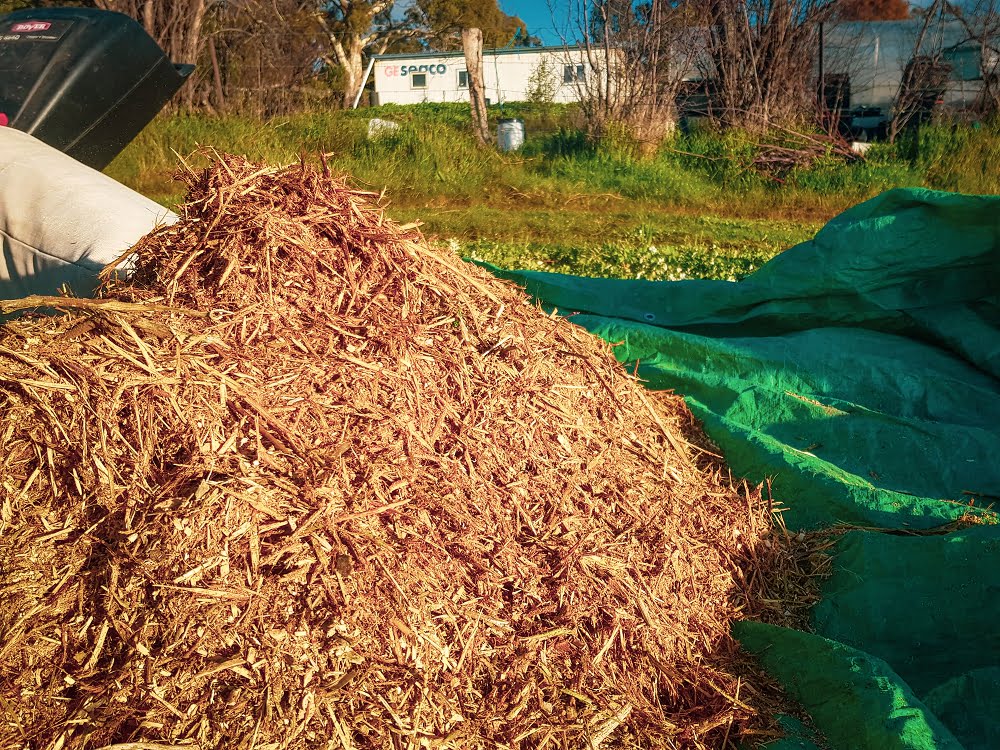
What’s wrong with weeds anyway?
The common understanding is that weeds will compete with your trees for water and nutrients.
For mature trees, plants under fruit trees bring many benefits. We encourage you to stop thinking of them as weeds and start thinking of them as your precious understory plants.
However, for young trees, the competition argument is somewhat true. It can be helpful to keep the weeds (especially grasses) suppressed while the tree’s roots are getting established.
We’ve always weeded around the very young trees in our on-farm fruit tree nursery, but these days we’re moving towards using woody mulch around the trees.
We also saw this in action at the Maine Heritage Orchard in Unity, Maine. This orchard was planted not that many years ago on the site of a disused gravel pit, in terrible soil. Major soil building and remediation have been the order of the day.
Hardwood chips have been extensively used as mulch around the trees when they were planted. The same chips have also been used to build soil more generally, and as an ongoing weed suppression tool, even as the trees mature. They’ve even been used to build paths.
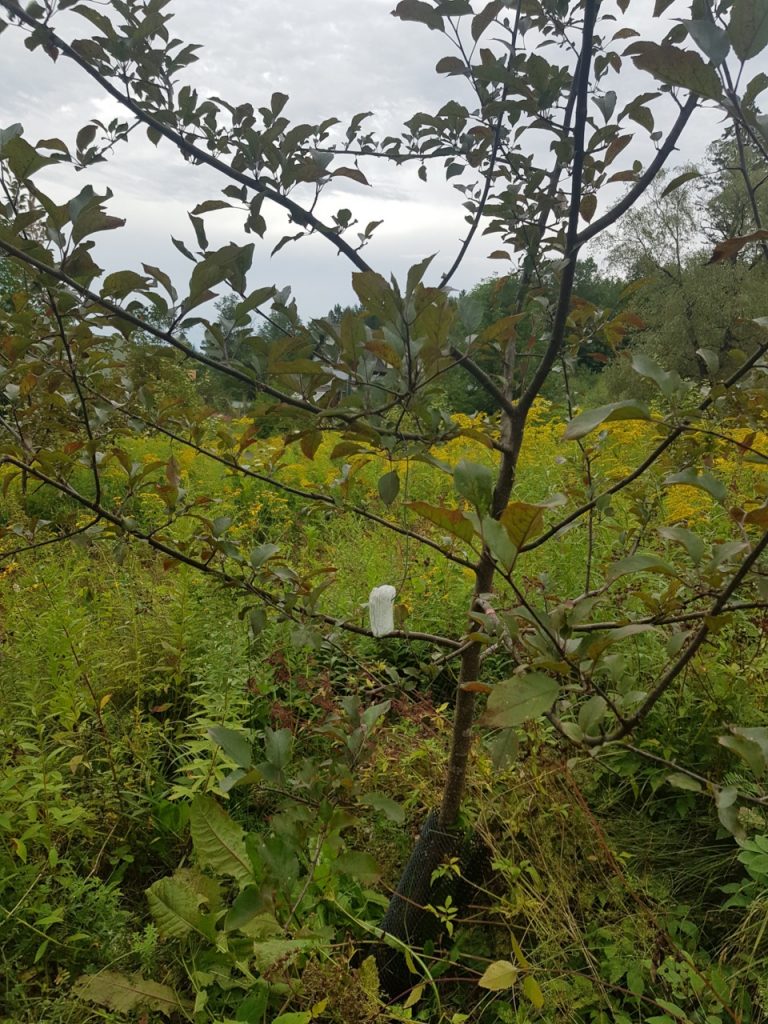
The case for woodchip mulch under mature fruit trees
We saw a different approach in Michael Phillips’ orchard in New Hampshire. Michael is author of The Apple Grower: A Guide for the Organic Orchardist.
Sadly, Michael is no longer with us, but we were lucky enough to be able to visit his farm, spend some time with him, and have a tour of his orchard.
Michae’s mulch strategy was to use woodchips on young trees, but welcome a wide diversity of understory plants as the trees grow, using mulch in a more ad hoc way.
There is widespread agreement that if you are going to mulch, hardwood woodchips are preferable. This is because, as woodchips break down, they provide the perfect environment for healthy soil fungi to thrive.
Understanding the amazing world of soil microbes that are key to the Natural Fertility System will change the way you think about soil, fertiliser, and mulch forever.
So, to mulch, or not to mulch?
After everything we’ve seen, we’re still in favour of mulching while the trees are young, and then transitioning to either a natural or cultivated understory for older trees – a “living mulch”!
Related Articles
Animals, fruit trees, and electric fences
Animals and fruit trees go well together if you can figure out how to enjoy the benefits without the animals doing too much damage.
3 simple ways to improve your soil
Here are 3 simple ways to kickstart the health of your soil to help you grow fruit that is full of vitamins and minerals.
Fruit tree leaves: bonus or problem?
Should you let the leaves from your fruit tree stay on the ground in autumn, or are you just asking for trouble? We’ll help you decide.

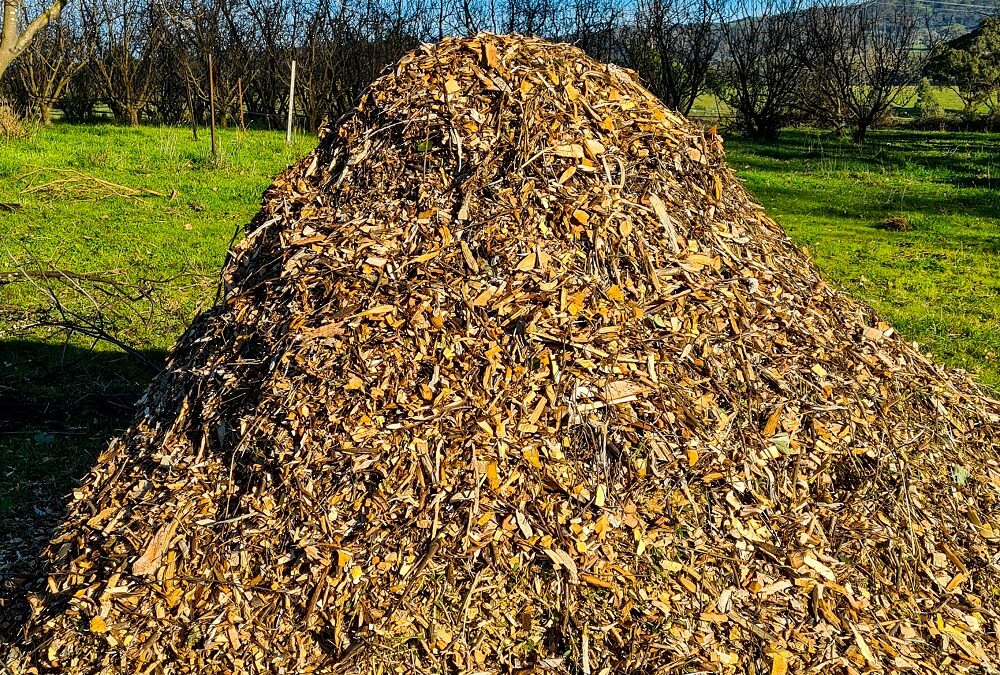

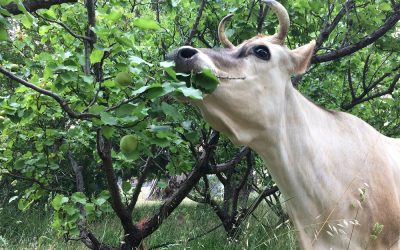

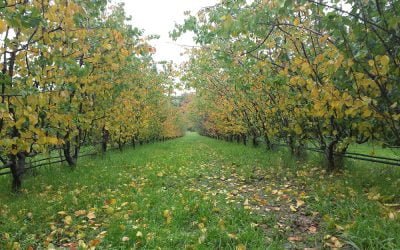


Hi guys, just wondering if you have any idea whether Eucalyptus wood chips can be used successfully as a mulch?
Thanks Vanessa
Hi Vanessa, yes eucalyptus mulch is fine but it should be aged first for a couple of reasons. The first is to give the volatile oils a chance to gas off, and the other is that fresh mulch can rob the soil of nitrogen.
Hi Katie, roughly how long would you age the eucy mulch?
Hi Stuart,
Good to age eucy mulch for 3 months+. It should lose that fresh green look and be looking grey and old rather than green and fresh.
Hi Katie, have you used eucalypt mulch in your orchard? Keen to hear if there are any long term negative effects on soil Biology. I have always turned down such mulch in favour of white wood deciduous such as willow, alder, birch etc. Thankyou!
Hi Michelle, some eucy mulch is fine, and if you dig about under any mature gum tree in the bush you’ll find that the understorey breaks down nicely and fungal growth is plentiful (in fact we use this as source material to brew a nice fungally-dominant compost tea). So it depends how you’re planning to use the mulch – if you’re thinking of complete mulch cover and maintaining the cover for more than one season then the willow etc. is probably better. In the orchard, we’re more in favour of occasional use in piles here and there (the method recommended by Michael Phillips), in which case using some eucy mulch will encourage fungal growth just fine.
Hi team, I have feijoa, imperial mandarin and lemon trees i use a mushroom and organic compost together and a pine bark mulch on top usually once a year around early spring here in Perth….what do you think?
Hi Lucia,
We love the adage ‘if in doubt, add organic matter’ – so, *almost* anything is better than nothing! Pine bark can be quite acidic so definitely good that you’re mixing it with some compost to help keep those citrus fed. In the long run, pine bark on its own might not be so great for the citrus with that acidity. Citrus will do really well with some of the nitrogenous mulches (like lucerne or pea straw), even better if they are used with healthy bit of composted manure. Finally, we reckon the best type of mulch is a living one, so have a think about what ground covers and understory plants might work in your conditions. Whatever you do, keep working on building up that soil with layers of good organic matter and plants and your citrus will thank you! Good luck – Meg, Grow Great Fruit team.
I am curious to know what you would include as living understory for your mature fruit trees?
Great question Deborah, there’s such a long potential list of plants we won’t go into them here, but this is a topic we explore in in-depth in several different resources.
We’d highly recommend you have a look at “The ‘Under Story’ Masterclass” by Dr. Christine Jones – https://growgreatfruit.com/product/the-under-story-masterclass/. Also our “Guide to Edible Flowering Plants” (https://growgreatfruit.com/product/guide-to-edible-flowering-plants/), or “Build Soil Fertility with Green Manures” (https://growgreatfruit.com/product/develop-your-green-thumb/) all have plant lists.
Can straw be used around 2-3 year old fruit trees?
Hi Karen – you absolutely can! Being mindful of the type of straw you might use is important though. There are also plenty of other amendments you can add to improve your soil health, as well as considering the use of plants as understory for multiple benefits to your soil & tree health. You might find our other recent post on soil improvements helpful to consider all of your options. Thanks – Meg, Grow Great Fruit Team
Hello, I’m a long time organic vegetable, melon and flower gardener who just acquired a property with 200 apple, peach, and pear trees in zone 5B. I’ve never grown fruit trees except for potted indoor/outdoor citrus and am feeling totally overwhelmed. Thanks for this great resource; I’m just struggling to process all this new info. About 50% of my trees look to be about 4-5 years old while the rest are between 2-3 years old. When I first saw them grass and assorted weeds were growing around the bases of the trees. Should I do anything about these weeds? Can anyone be kind enough to give me a summary of the top few things to do this first season? I don’t think I can afford to mulch 200 trees but maybe I’m mistaken. In any case, suggestions are very welcome, thank you
Hi Dee,
Wow – sounds like a huge undertaking, and definitely could be overwhelming. You’ve got this – all the information is out there, it’s just applying it at the right times :). When it comes to your questions about weeds – you might find our masterclass by soil scientist Dr Christine Jones helps to explain some of the theory about what you could or should do (and why ‘weeds’ might be great for your soil!). This blog introduces some of those ideas too and might help you to decide what to do. In the long run, make sure you’re signed up for our newsletter so that you can find out about our next ‘Learn. Plan. Succeed’ 5 day intensive – we build a fruit tree action plan in that course and it sounds like you might need a thorough plan to work from for your orchard!
Good luck, Meg – GGF team.
I have mulched my fruit trees in the past with wood chips that has been aged a bit. But I need to apply some more again but all I have is fresh wood chips that I just got from the tree trimming crews. Do you see any problem with me using the fresh chips?
Fresh chips can cause something called ‘nitrogen drawdown’ which can sometimes inhibit plant growth in the short term – as they decompose, they suck up nitrogen from the soil (and then eventually release it down the track). So you could use them but add a source of nitrogen to support that decomposition process, Meg – GGF team.
Hi there just wondering about manure as a feed in winter? Whats the best way to break it down or compost before applying and how long for? Horse poo? Which is best please and how best to apply it Thanks
Hi Wendy, it probably depends what sort of composting system you have. It’s a good idea to hot compost horse poo if that’s what you’ve got, just because it can have quite a high weed seed content. To compost manure, you’ll want to have some source of carbon to help break it down. Good luck, Meg – GGF team.